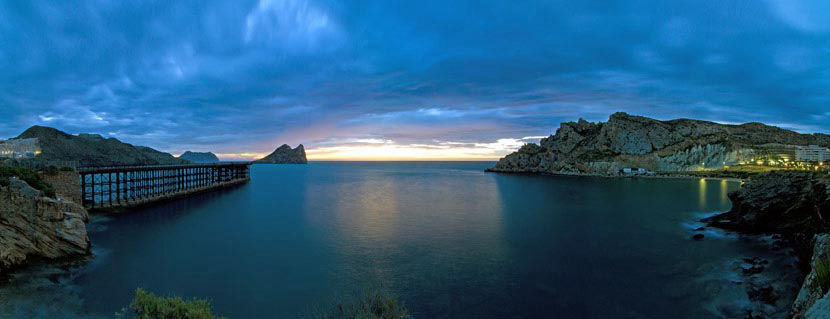
INTRODUCTION

We start our visit with the audioguide from the Aguilas tourism office, and work our way westward, crossing Isaac Peral street, to reach the building in which the Casino of Aguilas is situated.

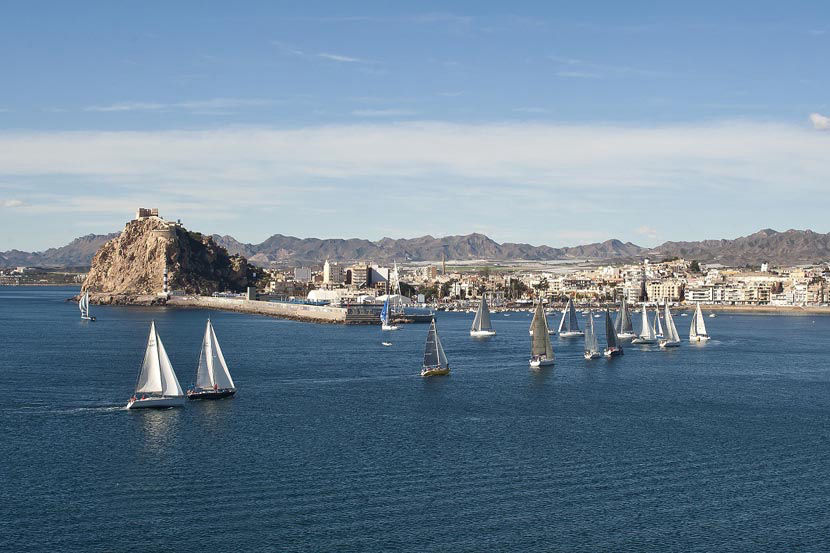
AGUILAS CASINO
As we can see with the audioguide, the casino is located quite near the sea. It’s a building with a simple décor, but is notable for its noble facade. It has three floors, with the rooms spread around its spacious lobby. Ten allegorical paintings featured on the main floor, date from 1905, and are the works of Murcian José Sanchez, a disciple of the painter from Cartagena, Wessel de Guimbarda. The paintings are located on the ceiling of the portico that accesses the lobby, and on the surrounding walls. There were also, apparently, paintings in the adjoining rooms, but they are no longer there.
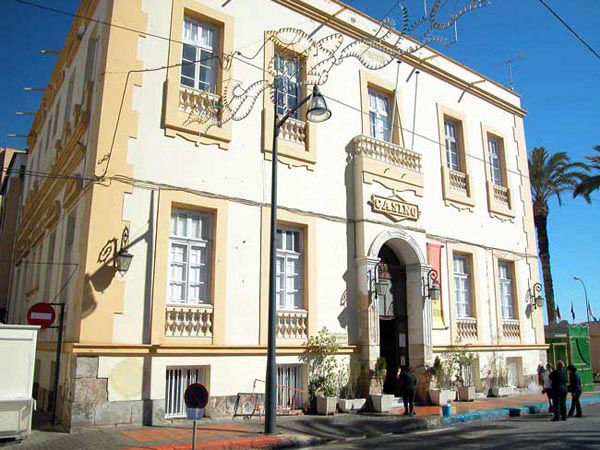
It is one of the few examples of existing beach casinos in Murcia. These establishments were used mainly as leisure playgrounds by vacationers, who had permanent residences there. Aguilas Casino is included in the central registry of Cultural Interest centers of Spanish Historical Heritage. Today, this historical building is an important cultural center of this coastal city. Although the origin of Aguilas Casino as an association dates from 1876, construction was not initiated until 1894, and completed in 1895. Construction was carried out by the local labor contractor José Pérez Sánchez, according to the plans of the architect Emiliano de la Cruz.
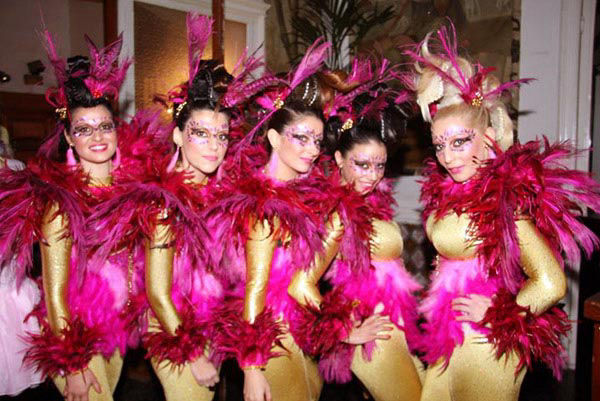
The project, designed with two floors and a basement, became a building of great nobility and simplicity in décor. The casino’s dominance over the rest of the buildings in the area, was mainly due to its architectural dimensions. It’s square layout is set around an illuminated courtyard, with a metal enclosure over it. The decorative program of Aguilas Casino was conceived as an expression of the bourgeois values of the time, as the building was intended for vacationers, particularly for the high society of Lorca. They turned Aguilas into their favoured destination. The staircase, and the illuminated yard, towers above the building. It’s here where we find a number of paintings, the works of José Sanchez Carlos from 1905, mentioned earlier.
On the stairway, you’ll see with the audioguide a painting with a rider carrying a torch, which is being driven by a female figure with a lyre (“liar”). On the other side of the painting, a man is falling with a snake curled over his foot. According to the book of Jorge Aragoneses on decorative painting in Murcia, these elements are allegories of the triumph of good over evil, light over darkness and truth over falsehood. In the courtyard we can find several paintings embedded with mouldings made of plaster; a midwife, which, by her attributes, has been interpreted as the symbol of wisdom and agriculture. There are also other elements that are employed as allegories addressed to war, and art; two working women interpreted as symbols of the home and finally, an allegory of Murcia, represented by Charity.
The paintings in the Ballroom, depicting a number of bucolic landscapes, were removed from their location in 1930. Since the late 19th century, the allegorical paintings have been used to decorate several of the main buildings in the cities. It added to the nobility of the property. This is why such a style of décor, that we see here, was selected for the casinos of the period. We leave the casino to go down Coronel Pareja street, towards the Square of Spain. Once we reach the Square, we’ll see, to our right, about 20-meters distant, the building of Saint Joseph’s Parish.
SAINT JOSEPH’s PARISH (19th century)
The parish church of Saint Joseph of Aguilas that you can visit with the audioguide is located in the Square of Spain, in the city center. Construction on the church lasted forty-two years, from 1810 to 1853. It’s a church that has a rectangular floor, and is divided in three naves, covered with semicircular shaped vaults with lunettes. The choir loft is high, and is located at the entrance. A raised, lit, semispherical dome stands in the middle of the transept. The sober, neoclassical decor combines gray and white tones. Paired pilasters, topped by Ionic capitals, are located at the laterals of the central nave. Modern liturgical requirements demanded the construction of a floorboard with an altar.
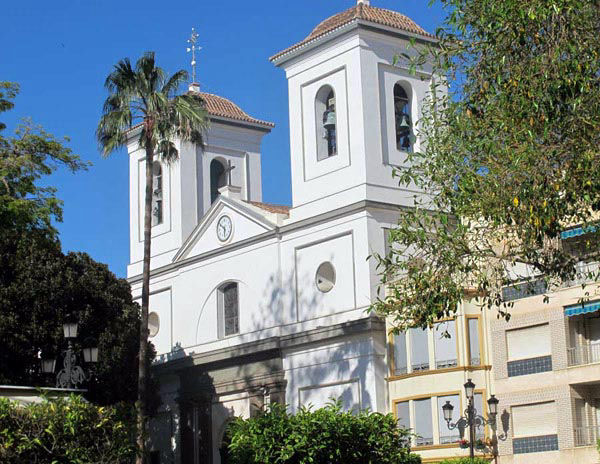
Initially, the sacristy was located to the right of the high altar. Today it stands at the entrance of the church. To the left of the main altar, we find the Holy Sacrament Chapel, with the Tabernacle and the image of the Sacred Heart of Jesus. Next to this image, we can see two paintings of the painter Muñoz Barberán, who was from Lorca. The altarpiece, made of marble, has been recently built and placed here, due to reconstruction performed on the presbytery in 2003. The windows were also replaced by new ones, that show various scenes from the life of Saint Joseph and the Virgin Mary. On the altars of the lateral naves, we see with the audioguide a kind of reredos of white, red and dark gray marble from Macael.
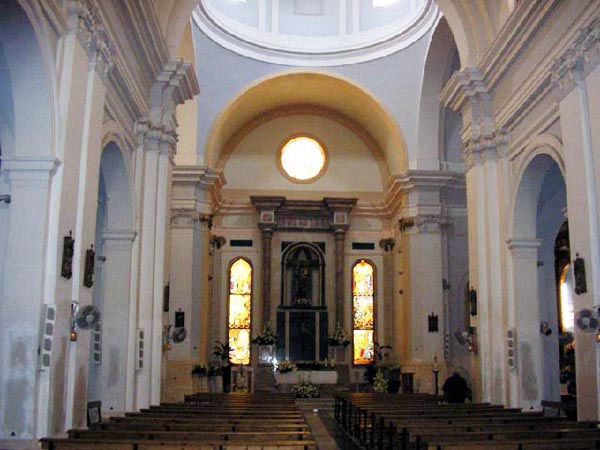
The plain facade is framed by two bell towers. There are only double pilasters flanking the access to the temple. There is a large window above the temple that lights the choir loft. Initially, this window was flanked by double pilasters, but today it is presented in a semicircular shape. This transformation was carried out and financed by Alfonso Escámez in 1988. It is recorded on a tombstone at the entrance of the church. A triangular pediment crowns the façade and also contains the clock. Most of the temple images were made by sculptors of the 20th century, though some ornaments relating to worship came from donations in the previous century.
SCULPTURE HIGHLIGHTS OF THE TEMPLE:
Our Lady of Sorrows is the next section of this audioguide: This virgin is situated in the central niche of the neoclassical altarpiece. It has four large columns of compound capital, and is crowned by a curved pediment, which is set in the right transept of the church. This is a clothed image, because only the head, hands and feet are carved. This image follows the typology created by Francisco Salzillo, posing with open arms in a declamatory pose with an upward look This pose signifies the moment before the death of Jesus. Our Lady of Sorrows was declared the Private Patroness of the village, by a resolution adopted in a special session of the Corporation on October 2nd of 1855. On August 15th of 1963, the virgin was proclaimed Canonical Patroness of Aguilas, under the papal decree of Pope John the XXIII. Finally, she was crowned on October 2nd of 2000 by the Bishop of Cartagena-- Monsignor Manuel Ureña. This act ratified that the Catholic citizens of Aguilas had chosen Our Lady of Sorrows as their patroness long ago. During the Civil War, the church of St. Joseph was destroyed, and all of its images were burned, except the Virgin of Sorrows. Controversy surrounds the question of who is the creator of this virgin. Some researchers believe that it is a work of Francisco Salcillo, while others believe that it was made by his disciples. Amongst them, Roque Lopez is the main candidate. However, the creation of the virgin appeared in some publications as the work of Fernández Caro.
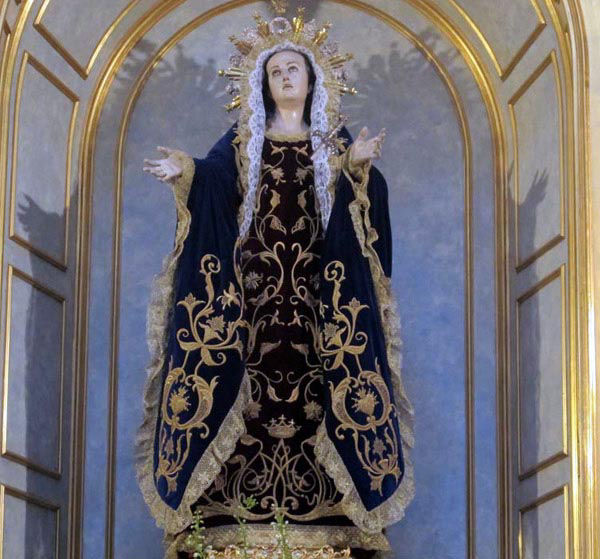
Christ of Agony--- from the mid-20th century: The artist is José Rivera. It is a crucified Chris, made of polychrome wood. The sculpture is noted for its powerful anatomy and muscle tension. The work represents Christ still alive, in full agony, with bruises on various parts of his body.
Our father Jesus of Nazareth—from the 20th century—This sculpture is located at the entrance of the church, in the nave of the Epistle. This is a clothed image that represents Christ carrying the Cross. To increase the realism, the Son of God has false hair, and is wearing a superimposed crown of thorns.
Reclining Christ -- 20th century--- by Francisco Liza: This is a life-size polychrome wood carving.
A niche with a Gothic arch has been recently opened in the wall of the left transept, next to the large religious picture of Manuel Coronado. The niche houses a small image of the Virgin of El Rocío.
The Blessed Virgin Mary of the 20th century: This image is located in the third altar on the Gospel side. The Virgin holds the Child with her left hand, while in the right one she has a small scapular. She is wearing a dark tunic and a clear coat, as you can see with the audioguide.
The Sacred Heart of Jesus stands with outstretched arms in the chapel of the Holy Sacrament. We can see the image of Saint Anthony of Padua in the altars on the Epistle side. The saint carries the Child in his arms. There is a depiction of a reclining Christ on an urn at his feet. St. Joseph with the Child, a 20th century image, appears in the altarpiece.
PAINTING HIGHLIGHTS OF THE TEMPLE:
Two paintings are worth mentionning in this audioguide.
Painting of Saint Joseph. This painting is an oil-on-canvas, dating from 1946, and made by José Matrán Tudela. He was an aquiline painter and photographer born in 1888, who was also noted for his pen drawings. This is a representation of the Patriarch as a young man on clouds, holding the Child Jesus in his left arm, while, with his right hand, he tenderly takes the Child´s hand. They are surrounded by angels. One of them bears the flowering staff, the symbol of Saint Joseph. The setting is crowned by a figure of the Holy Spirit.
Painting of Manuel Muñoz Barberán: This painting is located in the Holy Sacrament Chapel, constructed in the early years of this century. This is The Last Supper, oil-on-canvas, depicting the Last Supper of Christ as he was blessing the bread. The figures are arranged around a rectangular table. Upfront can be seen a wash basin for washing the feet. Muñoz Barberán created a composition with abundant biblical details, which indicate that he was an expert of the gospel. Upon leaving the church, we reach the center of the Square of Spain.
THE GARDEN OF THE SQUARE OF SPAIN
We are enjoying with the audioguide a beautiful garden with a wide variety of trees and plants of different species. The most outstanding plants are the ancient Ficus from Brazil. A British evangelical Christian missionary, named Leon Armstrong, ordered that these trees be brought here. While we take a walk around the garden, you will see, in the center, a fountain with a sculpture, commonly known as "La Pava de la Balsa". As we approach, we find an sculpture of a duck, which is being bitten by a snake. It symbolizes the struggle of good and evil. Since its construction in 1874, this square is the "heart of Aguilas." Eight principal blocks of the city converge in this street. There are many 19th-century facades around the square, enhancing the beauty of this municipality, especially those that face the South side. On the West side, the 19th-century -style façade of the Town Hall is dominant.
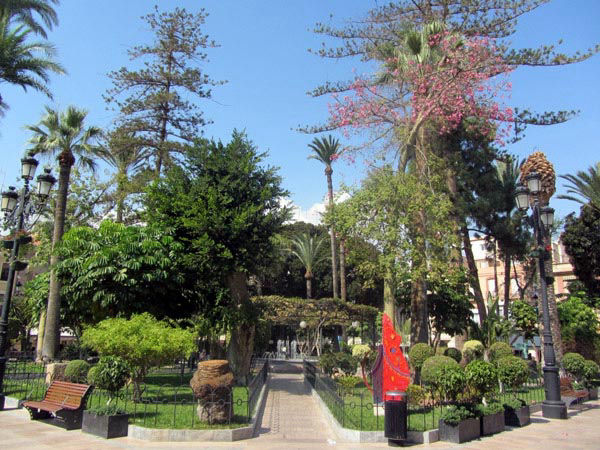
FACADE OF THE TOWN HALL
The Town Hall is located at No. 14 of the Square of Spain, and was built in the 19thcentury by the landowner Mr. Juan Ruano Blazquez, who was the husband of Mrs. Mary Baldrich. In 1939 the house became municipal property. The facade is Neomudejar style. During its construction, Castilian or Toledo type bricks were used. It created embossed abstract forms in some areas such as under the eaves. The windows are crowned with horseshoe and scalloped arches. There are other decorative elements of Moorish inspiration, used to decorate the bay windows. These ornaments, made of ceramic, reproduce abstract geometric shapes, based on a combination of squares. They eventually form stars of various types and meanings. The star of David is featured among them. It is a recurring pattern that frequently appears in artistic expression, symbolizing the mystical union between man and woman. These decorations can also be noticed in the woodwork, especially on the 3rd floor.
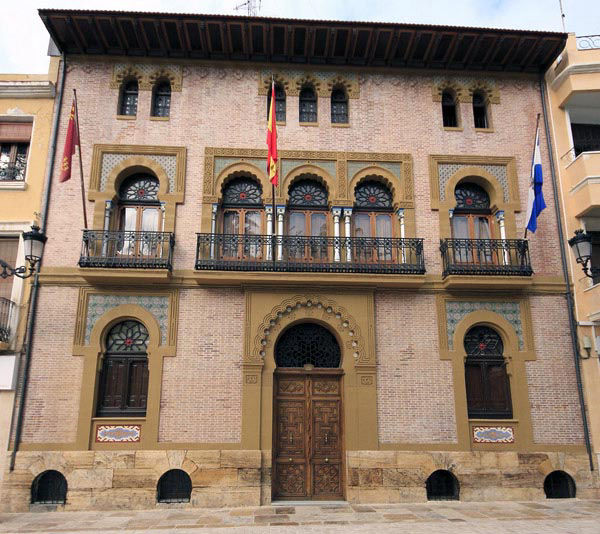
The metal decoration includes iron works in the form of six and eight point stars in the windows, the floral marble design that adorns the front door, and additional geometric décor in the other bay windows. On the balconies, the railings reproduce geometric forms of Islamic character. This theme is enhanced by the inscriptions that can be seen with the audioguide on the main balcony. It is over the stone capitals that support the arches. The characters are similar to Kufi script. There, one can read, translated into Castilian, "the family dream". In the capitals, you can see the presence of a shell and other objects. From the vicinity of the Town Hall, we now turn to the Archaeological Museum of the city, walking on Conde de Aranda street.
ARCHAEOLOGICAL MUSEUM
After learning a little more about the history of Aguilas in this museum thanks to the audioguide, we’ll cross the Square of Spain once again in order to reach the Castle of Saint John of Aguilas. We’re coming up Murillo street to reach the path that accesses this monument.
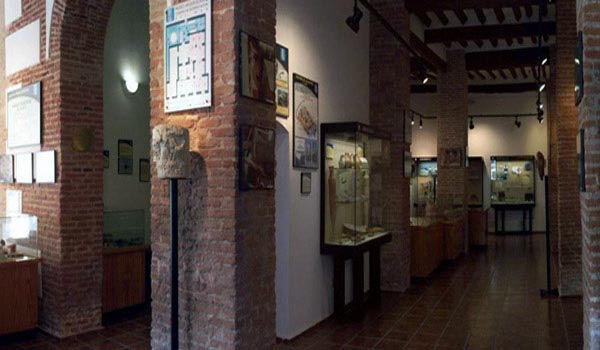
CASTLE OF SAINT JOHN OF AGUILAS
Coming down from the castle, towards the port side, taking the road parallel to the Square of Robles Vives, we can find with the audioguide the "Francisco Rabal" house of culture.
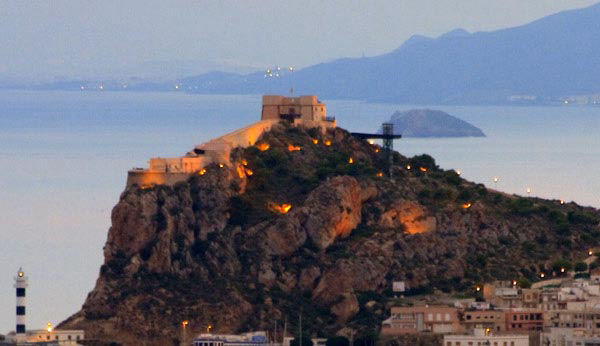
FRANCISCO RABAL HOUSE OF CULTURE
The house opened in 1991, and is located in the Square of Asunción Balaguer. Here, we have Manuel Coronado exhibition hall a spacious meeting room, various multipurpose rooms, the Public Library and the Jose Matrán Museum Room. The house features prizes, trophies and other awards granted to the aquiline actor Francisco Rabal, for whom the museum was named. The museum also exhibits the awards of his daugther, Teresa Rabal, who was an actress as well. Also, you can visit the various exhibitions of painting, photography and crafts that are performed here throughout the year. Currently, an important expansion of this building is underway. Back on the outside, from the Square of Asunción Balaguer, we walk with the audioguide towards the port of Aguilas.
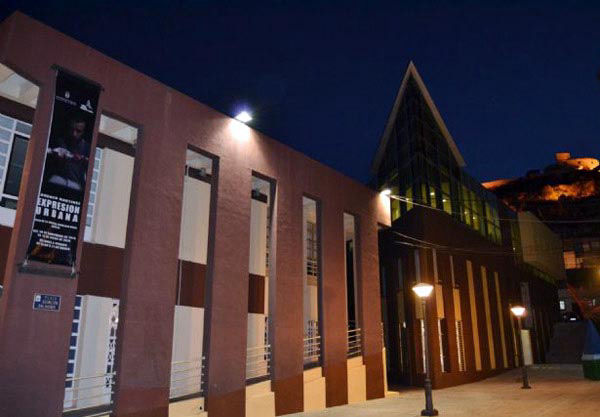
FISHING PORT
Work on the port was completed in 1884, and from that moment on, the commerce of Aguilas has flourished. Minerals of Sierra Almagrera, lead ore of Sierra Almenara, esparto grass and minerals from Granada, Murcia, Albacete, Almería and Jaen used to be shipped from this port. Ships from England unloaded their cargo of coal. Other ships brought cement from Catalonia, Scotland and Northern Africa. During the years 1912 to 1925, many ships used to arrive at this port. Sometimes, there were seven or eight vessels at the docks simultaneously. This port ceased operations in 2001. It is located at a longitude of 37 degrees 27 minutes, 7 seconds west of the Greenwich Meridian. For many years, the fishing port was home to the largest fleet in the Region of Murcia. It is very interesting to watch the auction and sale of fish that occurs in the market, near the port, on weekdays. To our right, at the foot of the Castle of Saint John, we can find with the audioguide the Lighthouse of Punta Negra.
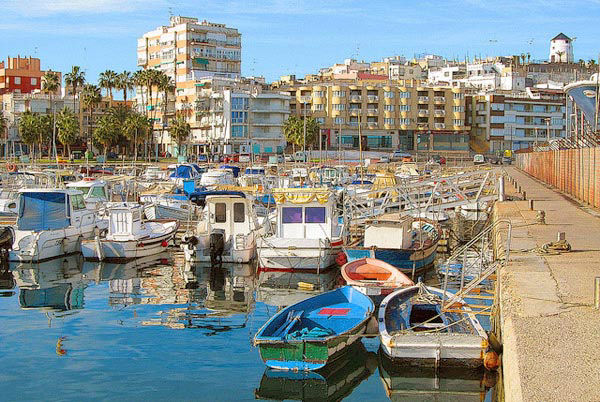
THE LIGHTHOUSE OF PUNTA NEGRA
This lighthouse is located at the foot of the castle, near the commercial port. It is 30.9 meters high above sea level, with a range of 15 miles, and an electric lighting system. This lighthouse replaced the old-one, known as the "White Lighthouse", built in 1859. The "White Lighthouse" was lit for the first time on August 30th, 1860. Now, we take a pleasant walk with the audioguide along the harbor towards the North side, leaving the lighthouse behind us. On the way, we find an amazing sculpture: The Icarus.
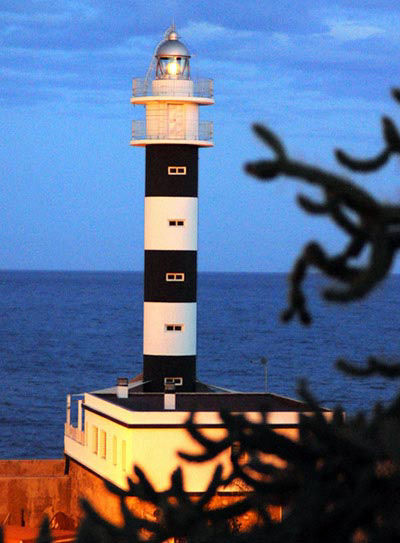
ICARUS MONUMENT
This bronze Icarus stands with its back turned to the sea, and looks toward theTown. The monument is a work of González Beltrán, and honors the carnival of Aguilas. The 2.5- meter high character from Greek mythology is extending his wings, inspiring us to flight, at least in our imagination. We continue walking with the audioguide, and a few meters further, we look up to see another emblematic monument of Aguilas: the mill of Sagrera.
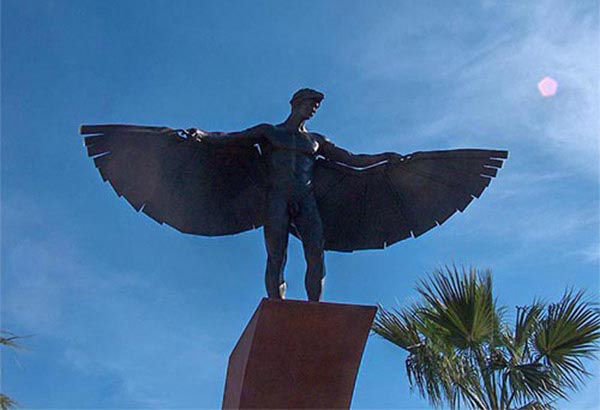
THE MILL OF SAGRERA
This mill is situated on a hill in the center of the town, facing the sea. This is a no-longer-used grain mill with an original touch, from where you can see the entire city. You reach it by going up narrow, winding streets. The gentle sea breeze slowly rotates its long blades of canvas. The mill blades seem to form part of the aquiline landscape, and enjoy a commanding view of the Bay of Levante and the port. Continuing our tour of the port, we get to the area called "la calica" where the “Royal Stairway” is located. This is an entry with stairway leading down to the sea. Across the walk, we observe with the audioguide the monument that honors the railroad.
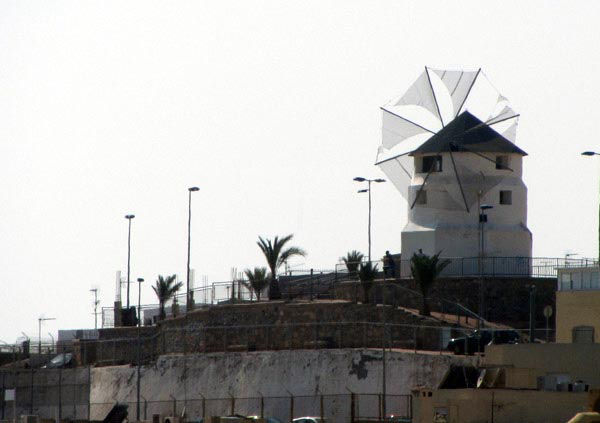
MONUMENT TO THE RAILWAY
This monument presents one of the first locomotives used in Águilas. The monument is a tribute to the railroad and its contribution to the economic development of the population. The locomotive was built in 1889 by Neilson in Glasgow, Scotland, and was later shipped to the port of Aguilas, and finaly assembled in the English workshops of the Neilson company in Aguilas. It officially began to provide service on Sunday, April 1st, 1890, the date coinciding with the opening of the Almendricos-Aguilas branch line. That line was taken out of service on November 15th, 1967. In the summer of 1969, the managing Director of Renfe, Alfredo Les Florestán, presided over the official presentation of the locomotive as a gift to the town of Aguilas. It was placed in the Square of Isaac Peral in August of 1970.
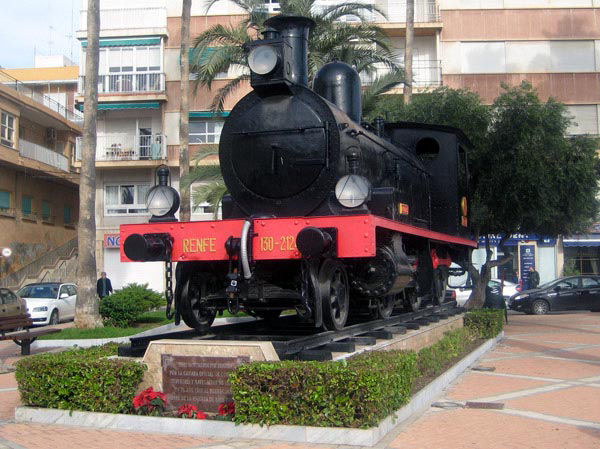
We walk along the Paseo of Parra with the audioguide, named in memory of an Aguilas´s poet of the 19th century. We are touring the beautiful crown shape Bay of Levante. Looking towards the sea, to our right, we can see the Castle of Saint John, the lighthouse of Punta Negra, and the fishing harbor with its market. In the middle we have the entrance to the sheltered bay, and, to the left, we find the peak and the viewpoint of l'Aguilica.
THE PEAK AND THE VIEWPOINT OF L'AGUILICA
Nature has rewarded Aguilas with this magnificent stone sculpture. It dominates the bay of Levante. As a result of sea erosion and wind, the sculpture resembles an eagle's beak coming out from the sea. From its viewpoint, a beautiful view of the city opens in front of us. Between the Yacht Club and the Peak of L'Aguilica, we find a building that grabs our attention because of its great beauty and innovative design, which is reflected in the sea. It is the Auditorium and Congress Palace of Infanta Doña Elena that you can see with the audioguide.
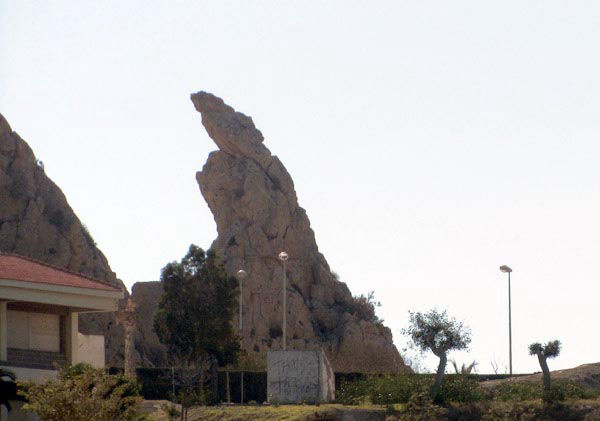
THE AUDITORIUM AND CONGRESS PALACE OF INFANTA DOÑA ELENA
The Auditorium and Congress Palace of "Infanta Dona Elena" is situated in the Bay of Levante, facing the Beach of Las Delicias. The building has an area of 8.773 square meters, with a number of levels. The project was the result of an European-wide design competition. The first level has an area of 2,112 square meters, and the building´s complete height is 25.5 meters. The project fulfills the needs related to the characteristics of the location. On one hand, there is the need that involves urban growth, and on the other hand, the need to preserving the natural beauty of the landscape in which it is located.
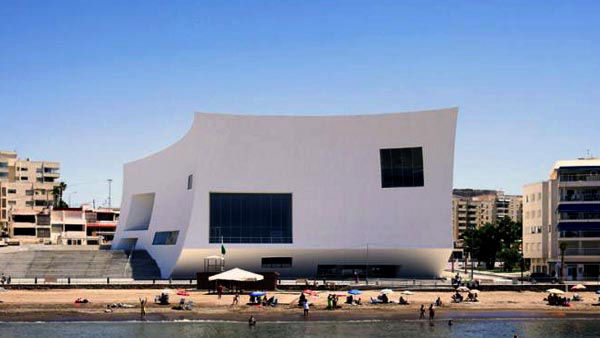
The installation relates to its surroundings. Facing the city, there are well-structured and orderly arranged buildings that make a block in the direction of the streets. Towards the sea, there are facilities that have been set according to the spaces and configurations of the landscapes and geography. These are spacious concave surfaces, weaving powerful relationships with the surrounding natural landscape. Different types of activities take place in this magnificent building, such as Conferences, Seminars, Fairs, Exhibitions, Conventions, Festivals, Public and Private functions, and all kinds of national and international meetings at a professional level. The Auditorium hosts various cultural activities: theater, dance, concerts as well as other picturesque events.
Tourist Office: Plaza Antonio Cortijos S/N 30880 Aguilas, Murcia
- Tel.: +34 96 849 32 85 - www.aguilas.es - turismo@aguilas.es -
Back to Index